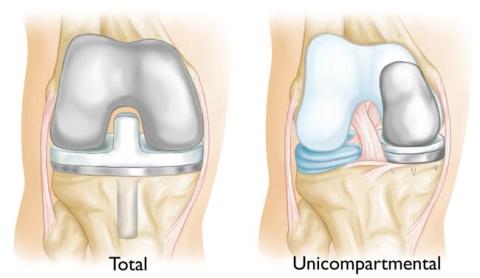
According to well-practised Spine surgeon, Dr. Faizan for patients looking to relieve pain from knee arthritis, total knee replacement, also known as total knee arthroplasty, can be an extremely effective option, but in some cases a less invasive partial knee replacement can also relieve knee pain.
A partial knee replacement is also known as a unicompartmental knee replacement. During this procedure, rather than replacing the entire knee joint, only the diseased portion of the knee is resurfaced. This procedure is an alternative to a total knee replacement for patients whose disease is limited to just one area of the knee, says Dr. Faizan.
A partial knee replacement (PKR) is a surgical procedure to replace only one part of a damaged knee. It can replace either the medial part, the lateral part, or the patella of the knee.
· Partial knee replacement has several advantages over total knee replacement, including shorter recovery time and more range of motion preserved after surgery. But partial knee replacement is only an option for people with knee damage in just one place, either lateral, medial or the patella.
· Surgery to replace the whole knee joint is called total knee replacement.
“The ideal candidate for a partial knee replacement has arthritis limited to one compartment of the knee, intact ligaments, normal range of motion, minimal deformity and is not excessively obese,” says Dr. Faizan, a total joint specialist at West Avenue Medical centre, Nagpur.
There are three compartments in a knee joint: a medial and lateral compartment between the ends of the femur (thigh) and tibia (shin) bones and a third compartment behind your kneecap.
If only one of the compartments in your knee joint is affected by arthritis, it is possible that a total joint specialist can resurface in just that one compartment, leaving the other two healthy compartments alone.
The most common reason for partial knee replacement is single-compartmental knee damage from advanced osteoarthritis.
Partial Knee Replacement is also used for individuals with joint disease resulting from Rheumatoid Arthritis, post-traumatic arthritis, and for moderate deformity of the Knee.
Partial knee replacement surgery improves pain and function similarly to total knee replacement in people with osteoarthritis that affects only a single compartment of the knee. Partial knee replacement surgery is also cheaper.
Benefits of a partial knee replacement
-
Smaller incision
-
Less blood loss
-
Faster recovery
-
Better range of motion
-
A more “normal” feeling knee
Risks of a partial knee replacement
-
A total knee replacement is more reliable in completely relieving pain for a longer period of time.
-
A partial knee has a higher revision rate or need for another surgery compared to a total knee replacement.
-
Rheumatoid arthritis patients have better success with total knee replacements.
“One of the most important factors that determines the success of a partial knee replacement is patient selection,” says Dr. Faizan. “When done for the right patient, with isolated damage to their knee, we can expect excellent results. For about 85 percent of our patients, their knee replacements last ten years or longer.”
Ultimately your total joint specialist like Dr. Faizan will work with you to determine whether you should have a partial or total knee replacement based on your activity level, range of motion before surgery, your age and knee deformity.

